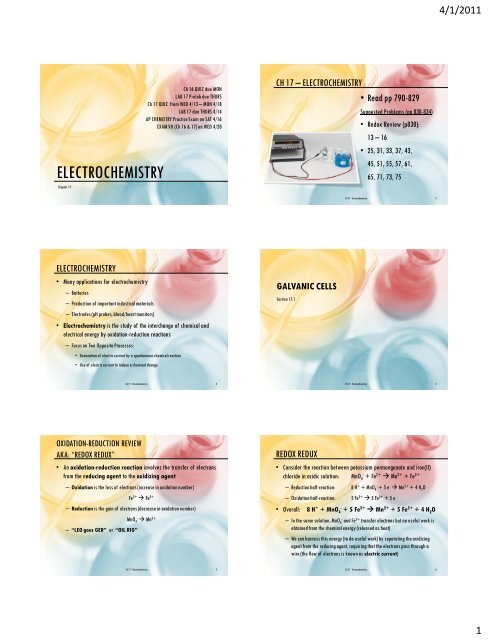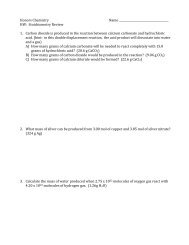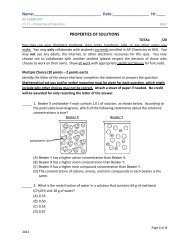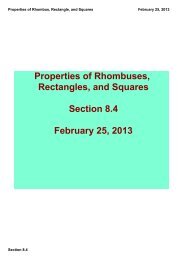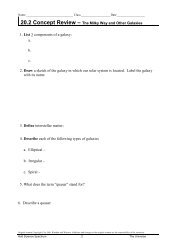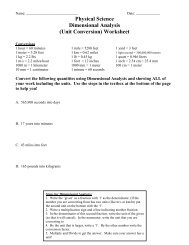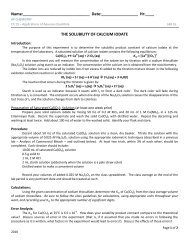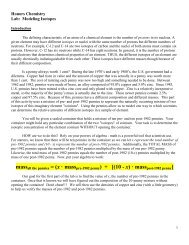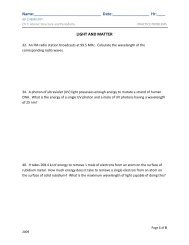Electrochemistry (Ch 17) - AP Chemistry
Electrochemistry (Ch 17) - AP Chemistry
Electrochemistry (Ch 17) - AP Chemistry
You also want an ePaper? Increase the reach of your titles
YUMPU automatically turns print PDFs into web optimized ePapers that Google loves.
4/1/2011<br />
ELECTROCHEMISTRY<br />
<strong>Ch</strong>apter <strong>17</strong><br />
<strong>Ch</strong> 16 QUIZ due MON<br />
LAB <strong>17</strong> Prelab due THURS<br />
<strong>Ch</strong> <strong>17</strong> QUIZ from WED 4/13 – MON 4/18<br />
LAB <strong>17</strong> due THURS 4/14<br />
<strong>AP</strong> CHEMISTRY Practice Exam on SAT 4/16<br />
EXAM VII (<strong>Ch</strong> 16 & <strong>17</strong>) on WED 4/20<br />
CH <strong>17</strong> – ELECTROCHEMISTRY<br />
• Read pp 790-829<br />
Suggested Problems (pp 830-834)<br />
• Redox Review (p830):<br />
13 – 16<br />
• 25, 31, 33, 37, 43,<br />
45, 51, 55, 57, 61,<br />
65, 71, 73, 75<br />
<strong>Ch</strong> <strong>17</strong> - <strong>Electrochemistry</strong><br />
2<br />
ELECTROCHEMISTRY<br />
• Many applications for electrochemistry<br />
– Batteries<br />
– Production of important industrial materials<br />
– Electrodes (pH probes, blood/heart monitors)<br />
• <strong>Electrochemistry</strong> is the study of the interchange of chemical and<br />
electrical energy by oxidation-reduction reactions<br />
– Focus on Two Opposite Processes:<br />
• Generation of electric current by a spontaneous chemical reaction<br />
• Use of electric current to induce a chemical change<br />
GALVANIC CELLS<br />
Section <strong>17</strong>.1<br />
<strong>Ch</strong> <strong>17</strong> - <strong>Electrochemistry</strong><br />
3<br />
<strong>Ch</strong> <strong>17</strong> - <strong>Electrochemistry</strong><br />
4<br />
OXIDATION-REDUCTION REVIEW<br />
AKA: “REDOX REDUX”<br />
• An oxidation-reduction reaction involves the transfer of electrons<br />
from the reducing agent to the oxidizing agent<br />
– Oxidation is the loss of electrons (increase in oxidation number)<br />
Fe 2+ Fe 3+<br />
– Reduction is the gain of electrons (decrease in oxidation number)<br />
– “LEO goes GER” or “OIL RIG”<br />
MnO 4- Mn 2+<br />
REDOX REDUX<br />
• Consider the reaction between potassium permanganate and iron(II)<br />
chloride in acidic solution: MnO 4- + Fe 2+ Mn 2+ + Fe 3+<br />
– Reduction half-reaction: 8 H + + MnO 4- + 5 e - Mn 2+ + 4 H 2 O<br />
– Oxidation half-reaction: 5 Fe 2+ 5 Fe 3+ + 5 e -<br />
• Overall:<br />
8 H + + MnO 4- + 5 Fe 2+ Mn 2+ + 5 Fe 3+ + 4 H 2 O<br />
– In the same solution, MnO 4- and Fe 2+ transfer electrons but no useful work is<br />
obtained from the chemical energy (released as heat)<br />
– We can harness this energy (to do useful work) by separating the oxidizing<br />
agent from the reducing agent, requiring that the electrons pass through a<br />
wire (the flow of electrons is known as electric current)<br />
<strong>Ch</strong> <strong>17</strong> - <strong>Electrochemistry</strong><br />
5<br />
<strong>Ch</strong> <strong>17</strong> - <strong>Electrochemistry</strong><br />
6<br />
1
4/1/2011<br />
A GALVANIC CELL<br />
A GALVANIC CELL<br />
• Unfortunately, this set up won’t work. <br />
– Electrons will flow from Fe 2+ to MnO 4- , but charge will build up in each<br />
compartment and stop the flow of electrons<br />
• A simple solution is to connect the solutions so that ions can flow to<br />
keep the net charge in each compartment zero.<br />
– A salt bridge is a U-tube filled with an electrolyte that will allow charges to<br />
flow from one compartment to another to keep the net charge zero<br />
– A porous disk (or cup in LAB <strong>17</strong>) can also be used to do the same thing<br />
• A galvanic cell is a device in which chemical energy is changed to<br />
electrical energy<br />
– Uses a spontaneous redox reaction to produce a current that can be used to<br />
do work<br />
– The reverse non-spontaneous process (converting electrical energy into<br />
chemical energy) is called electrolysis (Section <strong>17</strong>.7)<br />
• You remember LEO goes GER, but do you remember what color he is<br />
<strong>Ch</strong> <strong>17</strong> - <strong>Electrochemistry</strong><br />
7<br />
<strong>Ch</strong> <strong>17</strong> - <strong>Electrochemistry</strong><br />
8<br />
A GALVANIC CELL<br />
CELL POTENTIAL<br />
• “LEO is a RED CAT”<br />
– The electrode compartment in which reduction occurs is called the cathode<br />
– The electrode compartment in which oxidation occurs is called the anode<br />
• Reduction occurs at the cathode. Oxidation occurs at the anode.<br />
– Electrons are pulled from the anode to the cathode<br />
• The “pull” on the electrons is called the cell potential (E cell ) or the<br />
electromotive force (emf) of the cell.<br />
– Unit of electric potential is the volt (V)<br />
• 1 V = 1 J/C (joule per coulomb)<br />
– Measured with a voltmeter, but frictional heating of<br />
the resisters wastes some of the useful energy of the cell,<br />
so the reading will always measure less than the maximum cell potential<br />
– A potentiometer measures the cell potential under conditions of zero<br />
current with a variable-voltage device powering the reverse reaction<br />
– Modern digital voltmeters draw only a negligible amount of current<br />
<strong>Ch</strong> <strong>17</strong> - <strong>Electrochemistry</strong><br />
9<br />
<strong>Ch</strong> <strong>17</strong> - <strong>Electrochemistry</strong> 10<br />
STANDARD REDUCTION POTENTIALS<br />
Section <strong>17</strong>.2<br />
STANDARD REDUCTION POTENTIALS<br />
• A galvanic cell’s redox reaction can always be broken down into two halfreactions.<br />
The sum of the potential (E ) of each half-reaction equals the cell<br />
potential (E cell ).<br />
– For example, this cell reaction is:<br />
2 H + (aq) + Zn(s) Zn 2+ (aq) + H 2 (g)<br />
– The anode’s reaction (oxidation) is:<br />
Zn Zn 2+ + 2 e -<br />
– The cathode’s reaction (reduction) is:<br />
<strong>Ch</strong> <strong>17</strong> - <strong>Electrochemistry</strong> 11<br />
2 H + 2 e - H 2<br />
• This cathode uses a Pt electrode in contact with 1 M H + bathed in H 2 (g) at 1 atm and is called the<br />
standard hydrogen electrode<br />
<strong>Ch</strong> <strong>17</strong> - <strong>Electrochemistry</strong> 12<br />
2
4/1/2011<br />
STANDARD REDUCTION POTENTIALS<br />
• The total potential (E cell ) can be measured (0.76 V), but there is no way to<br />
measure the individual electrode potentials.<br />
– To calculate potentials for each half-reaction, the reaction<br />
2 H + 2 e - H 2<br />
• where [H + ] = 1 M and P H2 = 1 atm<br />
– has been assigned a potential of 0V<br />
– E anode can be calculated because<br />
E° cell = E° anode + E° cathode<br />
• As a result, the reaction, ZnZn 2+ + 2 e - has a potential of 0.76 V<br />
• Using the standard hydrogen potential as a reference, all other potentials<br />
can be determined experimentally.<br />
<strong>Ch</strong> <strong>17</strong> - <strong>Electrochemistry</strong> 13<br />
STANDARD REDUCTION POTENTIALS<br />
• What is the potential of the cathode<br />
– Anode: Zn Zn 2+ + 2 e -<br />
– Cathode: Cu 2+ + 2 e - Cu<br />
• Since E° cell = E° anode + E° cathode<br />
– E° cat = 1.10 V – 0.76 V = 0.34 V<br />
• By convention, the potentials of<br />
half reactions are given as reduction<br />
potentials and are tabulated in<br />
standard states in a list of standard reduction potentials<br />
<strong>Ch</strong> <strong>17</strong> - <strong>Electrochemistry</strong> 14<br />
STANDARD REDUCTION POTENTIALS<br />
STANDARD REDUCTION POTENTIALS<br />
• Combining two half-reactions to obtain a balanced oxidationreduction<br />
reaction often requires two manipulations:<br />
– One of the reduction half-reactions must be reversed (since redox reactions<br />
must involve a substance being oxidized and a substance being reduced).<br />
• The half-reaction with the largest positive potential will run as written (as a<br />
reduction)<br />
• The other half-reaction will be forced to run in reverse (as an oxidation)<br />
• The net potential of the cell will be the difference between the two:<br />
E° cell = E° cathode – E° anode<br />
– Or “change the sign and add” (by changing the sign of the oxidation reaction)<br />
<strong>Ch</strong> <strong>17</strong> - <strong>Electrochemistry</strong> 15<br />
STANDARD REDUCTION POTENTIALS<br />
• Combining two half-reactions to obtain a balanced oxidationreduction<br />
reaction often requires two manipulations:<br />
– Since the number of electrons lost must equal the number gained, the halfreactions<br />
must be multiplied by integers as necessary to achieve the<br />
balanced equation. However, the value of E° is not changed when a halfreaction<br />
is multiplied by an integer.<br />
• Since a standard reduction potential is an intensive property, the potential is not<br />
multiplied by the integer.<br />
STANDARD REDUCTION POTENTIALS<br />
• Consider a galvanic cell based on the redox reaction<br />
Fe 3+ (aq) + Cu(s) Cu 2+ (aq) + Fe 2+ (aq)<br />
– The half reactions are:<br />
Fe 3+ + e - Fe 2+ E° = 0.77 V (1)<br />
Cu 2+ + 2 e - Cu E° = 0.34 V (2)<br />
– To balance the cell reaction and calculate the standard cell potential, reaction (2)<br />
must be reversed and multiply reaction (1) by two:<br />
Cu Cu 2+ + 2 e -<br />
– The cell reaction becomes:<br />
-E° = -0.34 V<br />
2 Fe 3+ + 2 e - 2 Fe 2+ E° = 0.77 V<br />
Cu(s) + 2 Fe 3+ (aq) Cu 2+ (aq) + 2 Fe 2+ (aq)<br />
E° cell = 0.43 V<br />
<strong>Ch</strong> <strong>17</strong> - <strong>Electrochemistry</strong> 18<br />
3
4/1/2011<br />
GALVANIC CELLS<br />
• Consider a galvanic cell based on the reaction<br />
Al 3+ (aq) + Mg(s) Al(s) + Mg 2+ (aq)<br />
– The half-reactions are<br />
• Al 3+ + 3 e - Al<br />
E° = -1.66 V<br />
• Mg 2+ + 2 e - Mg<br />
E° = -2.37 V<br />
– Give the balanced cell reaction and calculate E° for the cell.<br />
• 2 Al 3+ (aq) + 3 Mg(s) 2 Al(s) + 3 Mg 2+ (aq)<br />
• E° cell = 0.71V<br />
LINE NOTATION<br />
• Line notation is handy for representing electrochemical cells.<br />
– The anode components are listed on the left and the cathode components are<br />
listed on the right, separated by double vertical lines (indicating the salt bridge<br />
or porous disk).<br />
• For example, the cell on the previous slide would be:<br />
Mg(s) | Mg 2+ (aq) || Al 3+ (aq) | Al(s)<br />
– Phase difference (boundary) is indicated by a single vertical line<br />
• Notice that the substance constituting the anode is far left and cathode is far right<br />
– Commas are used to separate ionic species in the same solution<br />
Pt(s)|ClO 3- (aq), ClO 4- (aq), H + (aq) ||H + (aq), MnO 4- (aq), Mn 2+ (aq)|Pt(s)<br />
<strong>Ch</strong> <strong>17</strong> - <strong>Electrochemistry</strong> 19<br />
<strong>Ch</strong> <strong>17</strong> - <strong>Electrochemistry</strong> 20<br />
COMPLETE DESCRIPTION OF A GALVANIC CELL<br />
• NOTE: A cell will always run spontaneously in the direction that<br />
produces a positive cell potential (E° cell )<br />
• A complete description of a galvanic cell includes:<br />
– The cell potential (always positive for a galvanic cell where E° cell = E° cat – E° an )<br />
and the balanced cell reaction.<br />
– The direction of electron flow, obtained by inspecting the half-reactions and<br />
using the direction that gives a positive E cell .<br />
– Designation of the anode and cathode<br />
– The nature of each electrode and the ions present in each compartment. A<br />
chemically inert conductor is required if none of the substances participating in<br />
the half-reaction is a conducting solid.<br />
DESCRIPTION OF A GALVANIC CELL<br />
• Describe completely the galvanic cell based on the following halfreactions<br />
under standard conditions:<br />
Ag + + e - Ag<br />
Fe 3+ + e - Fe 2+<br />
E° = 0.80 V<br />
E° = 0.77 V<br />
– Ag + (aq) + Fe 2+ (aq) Fe 3+ (aq) + Ag(s) E° cell = 0.03 V<br />
– Electrons flow from Fe 2+ to Ag +<br />
– Anode: Fe 2+ compartment Cathode: Ag + compartment<br />
– Pt(s)|Fe 2+ (aq), Fe 3+ (aq)||Ag + (aq)|Ag(s)<br />
<strong>Ch</strong> <strong>17</strong> - <strong>Electrochemistry</strong> 21<br />
<strong>Ch</strong> <strong>17</strong> - <strong>Electrochemistry</strong> 22<br />
CELL POTENTIAL, ELECTRICAL WORK, AND<br />
FREE ENERGY<br />
Section <strong>17</strong>.3<br />
CELL POTENTIAL AND WORK<br />
• The work that can be done by the electrons transferred<br />
through a wire depends on the “push” (thermodynamics)<br />
behind the electrons.<br />
– This electromotive force (emf) is defined in terms of a potential<br />
difference (in volts) between two points in the circuit (1 V = 1 J/C)<br />
– Cell potential (E ) and work (w) have opposite signs:<br />
w max = –qE max<br />
• In any real, spontaneous process some energy is always wasted – the<br />
actual work realized is always less than the calculated maximum<br />
<strong>Ch</strong> <strong>17</strong> - <strong>Electrochemistry</strong> 23<br />
<strong>Ch</strong> <strong>17</strong> - <strong>Electrochemistry</strong> 24<br />
4
4/1/2011<br />
CELL POTENTIAL AND WORK<br />
• Suppose a certain galvanic cell has a maximum potential (at zero<br />
current) of 2.50 V<br />
– In a particular experiment, 1.33 moles of electrons were passed through this<br />
cell at an average actual potential of 2.10 V. The actual work done is: w = -qE<br />
• 1 mole of electrons has a charge of 96,485 C (called a “faraday”, F = 96,485 C/mol)<br />
– Actual work: w = -(1.33 mol)(96485 C/mol)(2.10 J/C) = -2.69 x 10 5 J<br />
– Maximum work: w max = - (1.33)(96485)(2.50) = -3.21 x 10 5 J<br />
– The efficiency of this cell is:<br />
WORK AND FREE ENERGY<br />
• Since<br />
w max = ∆G<br />
– For a galvanic cell,<br />
w max = -qE max = ∆G<br />
– Since q = nF<br />
– Then,<br />
∆G = -qE max = -nFE max<br />
– Or<br />
∆G = -nFE<br />
– For standard conditions: ∆G° = -nFE°<br />
<strong>Ch</strong> <strong>17</strong> - <strong>Electrochemistry</strong> 25<br />
<strong>Ch</strong> <strong>17</strong> - <strong>Electrochemistry</strong> 26<br />
∆G = -nFE°<br />
• This equation states that the maximum cell potential is directly<br />
related to the free energy difference between the reactants and the<br />
products in the cell.<br />
– Provides an experimental means to obtain ∆G (as you will do in LAB)<br />
– Confirms that a galvanic cell will run in the direction that gives a positive<br />
value for E cell (positive E cell corresponds to a negative ∆G )<br />
CALCULATING ∆G°<br />
• Using the Standard Reduction Potentials Table, calculate ∆G° for the<br />
reaction:<br />
• Is this reaction spontaneous<br />
Cu 2+ (aq) + Fe(s) Cu(s) + Fe 2+ (aq)<br />
– E cell = 0.78 V<br />
– ∆G = -1.5 x 10 5 J (SPONTANEOUS)<br />
<strong>Ch</strong> <strong>17</strong> - <strong>Electrochemistry</strong> 27<br />
<strong>Ch</strong> <strong>17</strong> - <strong>Electrochemistry</strong> 28<br />
PREDICTING SPONTANEITY<br />
• Using the Standard Reduction Potentials Table, predict whether 1 M<br />
HNO 3 will dissolve gold metal to form a 1 M Au 3+ solution.<br />
DEPENDENCE OF CELL POTENTIAL ON<br />
CONCENTRATION<br />
Section <strong>17</strong>.4<br />
– E° cell = -0.54 V (not spontaneous under standard conditions)<br />
– General rule: Oxidizing agents (reactants) higher on the list<br />
will oxidize reducing agents (products) lower on the list<br />
• Ex: H + will react with Fe but not Ag<br />
• The best REDUCING AGENT is Li, the best OXIDIZING AGENT is F 2<br />
<strong>Ch</strong> <strong>17</strong> - <strong>Electrochemistry</strong> 29<br />
<strong>Ch</strong> <strong>17</strong> - <strong>Electrochemistry</strong> 30<br />
5
4/1/2011<br />
CONCENTRATION DEPENDENCE<br />
• For the reaction,<br />
Cu(s) + 2 Ce 4+ (aq) Cu 2+ (aq) + 2 Ce 3+ (aq)<br />
has a potential of 1.36 V under standard conditions (1 M<br />
concentrations all)<br />
– What if [Ce 4+ ] is greater than 1 M <br />
• Le <strong>Ch</strong>âtelier's principle predicts that the forward reaction will be favored,<br />
increasing the cell potential.<br />
– What if [Cu 2+ ] or [Ce 3+ ] is increased<br />
• Cell potential is decreased<br />
THE EFFECTS OF CONCENTRATION ON E<br />
• For the cell reaction,<br />
2 Al(s) + 3 Mn 2+ (aq) 2 Al 3+ (aq) + 3 Mn(s) E = 0.48 V<br />
predict whether E cell is larger or smaller than E cell for the<br />
following cases<br />
– [Al 3+ ] = 2.0 M, [Mn 2+ ] = 1.0 M<br />
• E cell < 0.48 V<br />
– [Al 3+ ] = 1.0 M, [Mn 2+ ] = 3.0 M<br />
• E cell > 0.48 V<br />
<strong>Ch</strong> <strong>17</strong> - <strong>Electrochemistry</strong> 31<br />
<strong>Ch</strong> <strong>17</strong> - <strong>Electrochemistry</strong> 32<br />
CONCENTRATION CELLS<br />
• A galvanic cell in which both<br />
compartments have the same<br />
components but at different<br />
concentrations is called a<br />
concentration cell (typically<br />
with small voltages)<br />
– What is the potential of this cell<br />
and what is the direction of<br />
electron flow<br />
– The relevant half-reaction is,<br />
Ag + + e - Ag<br />
E = 0.80 V<br />
CONCENTRATION CELLS<br />
• The electrons will flow in the<br />
direction that will equalize the<br />
concentrations of Ag + in the<br />
two compartments<br />
– Accomplished by transferring<br />
electrons from the 0.1 M Ag +<br />
compartment to the 1 M Ag +<br />
compartment<br />
– This produces more Ag + in the<br />
left compartment and consumes<br />
Ag + in the right compartment<br />
<strong>Ch</strong> <strong>17</strong> - <strong>Electrochemistry</strong> 33<br />
<strong>Ch</strong> <strong>17</strong> - <strong>Electrochemistry</strong> 34<br />
CONCENTRATION CELLS<br />
• Determine the direction of electron flow and designate the anode and<br />
cathode for the cell represented below.<br />
THE NERNST EQUATION<br />
• The concentration dependence of cell potential results directly from the<br />
dependence of free energy on concentration<br />
– Recall, ∆G = ∆G + RT lnQ where Q is the reaction quotient<br />
– Also recall, ∆G = -nFE and ∆G = -nFE<br />
– So, -nFE = -nFE + RT lnQ<br />
• Solving for cell potential,<br />
– Fe 2+ + 2 e - Fe<br />
– Transferring electrons from left (anode) to right (cathode)<br />
– This equation gives the relationship between the cell potential and the concentrations<br />
of the cell components is commonly called the Nernst equation (German chemist<br />
Walther Hermann Nernst, 1864-1941)<br />
– At 25C,<br />
<strong>Ch</strong> <strong>17</strong> - <strong>Electrochemistry</strong> 35<br />
<strong>Ch</strong> <strong>17</strong> - <strong>Electrochemistry</strong> 36<br />
6
4/1/2011<br />
CALCULATING E FOR NON-STANDARD CELLS<br />
• A galvanic cell based on the reaction,<br />
2 Al(s) + 3 Mn 2+ (aq) 2 Al 3+ (aq) + 3 Mn(s) E cell = 0.48 V<br />
– If [Mn 2+ ] = 0.50 M and [Al 3+ ] = 1.50 M, at 25C<br />
• The cell potential slightly decreases, as predicted by Le <strong>Ch</strong>atelier’s principle<br />
THE NERNST EQUATION<br />
• The potential calculated from the Nernst equation is the maximum<br />
potential before any current flow has occurred<br />
– As the electrons flow from the anode to the cathode, the concentrations will<br />
change and E cell will change as a result<br />
• The cell will spontaneously discharge until it reaches equilibrium<br />
– Where Q = K and E cell = 0<br />
– A “dead” battery is a galvanic cell which has reached equilibrium (∆G = 0)<br />
<strong>Ch</strong> <strong>17</strong> - <strong>Electrochemistry</strong> 37<br />
<strong>Ch</strong> <strong>17</strong> - <strong>Electrochemistry</strong> 38<br />
THE NERNST EQUATION<br />
• Describe the cell based on the following half reactions:<br />
VO 2+ + 2 H + + e - VO 2+ + H 2 O<br />
Zn 2+ + 2 e - Zn<br />
E = 1.00 V<br />
E = -0.76 V<br />
where T = 25C, [VO 2+ ] = 2.0 M, [H + ] = 0.50 M, [VO 2+ ] = 1.0 x 10 -2 M,<br />
[Zn 2+ ] = 1.0 x 10 -1 M<br />
– 2 VO 2+ (aq) + 4 H + (aq) + Zn(s) 2 VO 2+ (aq) + 2 H 2 O(l) + Zn 2+ (aq)<br />
– E cell = 1.76 V<br />
– E = 1.76 – -0.13 = 1.89 V<br />
ION-SELECTIVE ELECTRODES<br />
• Electrodes that are<br />
sensitive to the<br />
concentration of a<br />
particular ion are called<br />
ion-selective<br />
electrodes<br />
– Example: pH meter<br />
<strong>Ch</strong> <strong>17</strong> - <strong>Electrochemistry</strong> 39<br />
<strong>Ch</strong> <strong>17</strong> - <strong>Electrochemistry</strong> 40<br />
CALCULATION OF EQUILIBRIUM CONSTANTS<br />
FOR REDOX REACTIONS<br />
• For a cell at equilibrium,<br />
–E cell = 0 and Q = K<br />
• At 25C, the Nernst equation, with E = 0, can be<br />
rearranged to<br />
EQUILIBRIUM CONSTANTS FROM CELL POTENTIALS<br />
• For the oxidation-reduction reaction<br />
S 4 O<br />
2-<br />
6 (aq) + Cr 2+ (aq) Cr 3+ (aq) + S 2 O<br />
2-<br />
3 (aq)<br />
– the appropriate half-reactions are<br />
S 4 O<br />
2-<br />
6 + 2 e - 2 S 2 O<br />
2-<br />
3 E = 0.<strong>17</strong> V<br />
Cr 3+ + e - Cr 2+ E = -0.50 V<br />
Balance the redox reaction and calculate E and K (at 25C)<br />
– 2 Cr 2+ (aq) + S 4 O<br />
2-<br />
6 (aq) 2 Cr 3+ (aq) + 2 S 2 O<br />
2-<br />
3 (aq)<br />
– E = 0.67 V<br />
<strong>Ch</strong> <strong>17</strong> - <strong>Electrochemistry</strong> 41<br />
– K = 10 22.6 = 4 x 10 22 <strong>Ch</strong> <strong>17</strong> - <strong>Electrochemistry</strong> 42<br />
7
4/1/2011<br />
BATTERIES<br />
Section <strong>17</strong>.5<br />
BATTERIES<br />
• A battery is a galvanic cell or, more commonly, a group of galvanic<br />
cells connected in series, where the potentials of the individual cells<br />
add to give the total battery potential<br />
– Direct current (DC)<br />
– Common types:<br />
• lead-acid<br />
• acid dry cell<br />
• alkaline dry cell<br />
• nickel-cadmium<br />
• fuel cell<br />
<strong>Ch</strong> <strong>17</strong> - <strong>Electrochemistry</strong> 43<br />
<strong>Ch</strong> <strong>17</strong> - <strong>Electrochemistry</strong> 44<br />
LEAD STORAGE BATTERY<br />
• Lead storage batteries (lead-acid batteries) are commonly used in cars,<br />
boats, and scooters because they are durable, have long life, and can<br />
withstand temperatures between -30F and 120F<br />
– Anode: lead<br />
– Cathode: lead dioxide<br />
• Overall:<br />
Pb + HSO 4- PbSO 4 + H + + 2 e -<br />
PbO 2 + HSO 4- + 3 H + + 2 e - PbSO 4 + 2 H 2 O<br />
Pb(s) + PbO 2 (s) + 2 H + (aq) + 2 HSO 4- (aq) 2 PbSO 4 (s) + 2 H 2 O(l)<br />
LEAD STORAGE BATTERY<br />
• Six 2V cells provide<br />
the 12 V potential of<br />
a car battery<br />
• The car’s alternator<br />
charges the battery<br />
by forcing the reverse<br />
reaction to occur<br />
<strong>Ch</strong> <strong>17</strong> - <strong>Electrochemistry</strong> 45<br />
<strong>Ch</strong> <strong>17</strong> - <strong>Electrochemistry</strong> 46<br />
ACID DRY CELL<br />
• Anode: zinc Zn Zn 2+ + 2 e -<br />
• Cathode: carbon rod<br />
• Total potential: 1.5 V<br />
2 NH 4+ + 2 MnO 2 + 2 e - Mn 2 O 3 + 2 NH 3 + H 2 O<br />
ALKALINE DRY CELL<br />
• Same as the acid dry cell, but with KOH or NaOH instead of<br />
NH 4 Cl in the cathode<br />
– Alkaline batteries last longer because the zinc anode corrodes<br />
more slowly under basic conditions<br />
• Anode: Zn Zn 2+ + 2 e -<br />
• Cathode: 2 MnO 2 + H 2 O + 2 e - Mn 2 O 3 + 2 OH -<br />
<strong>Ch</strong> <strong>17</strong> - <strong>Electrochemistry</strong> 47<br />
<strong>Ch</strong> <strong>17</strong> - <strong>Electrochemistry</strong> 48<br />
8
4/1/2011<br />
NICKEL-CADMIUM BATTERY<br />
• Can be recharged (like lead-acid battery) because<br />
the products stick to the electrodes<br />
–Anode: Cd + 2 OH - Cd(OH) 2 + 2 e -<br />
–Cathode: NiO 2 + 2 H 2 O + 2 e - Ni(OH) 2 + 2 OH -<br />
OTHER BATTERIES<br />
<strong>Ch</strong> <strong>17</strong> - <strong>Electrochemistry</strong> 49<br />
<strong>Ch</strong> <strong>17</strong> - <strong>Electrochemistry</strong> 50<br />
FUEL CELLS<br />
• A fuel cell is a galvanic cell for which the reactants are<br />
continuously supplied (to “fuel” the spontaneous<br />
electrochemical reaction)<br />
– Hydrogen fuel cells<br />
• Used in the space shuttle to produce water<br />
• Automobiles<br />
• Anode: 2 H 2 + 4 OH - 4 H 2 O + 4 e -<br />
• Cathode: 4 e - + O 2 + 2 H 2 O 4 OH -<br />
• Overall: 2 H 2 + O 2 2 H 2 O<br />
CORROSION<br />
Section <strong>17</strong>.6<br />
<strong>Ch</strong> <strong>17</strong> - <strong>Electrochemistry</strong> 51<br />
<strong>Ch</strong> <strong>17</strong> - <strong>Electrochemistry</strong> 52<br />
CORROSION<br />
• Corrosion occurs when metals oxidize to form the ores in<br />
which they are naturally found<br />
– Because common metals (except Au) all have standard reduction<br />
potentials less positive than O 2 (g), oxygen can oxidize them.<br />
– Recall that any oxidizing agent (reactant) higher on the list can<br />
oxidize and reducing agent (product) lower on the list<br />
• Cu, Au, Ag, and Pt are relatively difficult to oxidize and are sometimes<br />
called the “noble metals”<br />
• Be sure to read section <strong>17</strong>.6 to learn about corrosion and<br />
corrosion prevention<br />
ELECTROLYSIS<br />
Section <strong>17</strong>.7<br />
<strong>Ch</strong> <strong>17</strong> - <strong>Electrochemistry</strong> 53<br />
<strong>Ch</strong> <strong>17</strong> - <strong>Electrochemistry</strong> 54<br />
9
4/1/2011<br />
ELECTROLYSIS<br />
• A galvanic (aka voltaic) cell produces current when a<br />
spontaneous redox reaction occurs<br />
• An electrolytic cell uses electrical energy to produce<br />
a non-spontaneous chemical change<br />
– Electrolysis occurs by forcing a current through a cell to<br />
produce a chemical change for which the cell potential (E)<br />
is negative<br />
– Applications: charging batteries, producing Al metal,<br />
chrome plating<br />
<strong>Ch</strong> <strong>17</strong> - <strong>Electrochemistry</strong> 55<br />
GALVANIC VS. ELECTROLYTIC CELLS<br />
Galvanic Cell<br />
• Anode: Zn Zn 2+ + 2 e - (-E = +0.76 V)<br />
• Cathode: Cu 2+ + 2 e - Cu (E = 0.34 V)<br />
Zn + Cu 2+ Zn 2+ + Cu (E cell = 1.10 V)<br />
– (E is positive, so ∆G is negative,<br />
spontaneous)<br />
– Electrons flow from Zn(s) to Cu(s)<br />
Electrolytic Cell<br />
• If an external power source<br />
provides a potential greater than<br />
1.10 V in the opposite direction,<br />
then the reverse reaction occurs<br />
Zn 2+ + Cu Zn + Cu 2+<br />
– Electrons flow from Cu(s) to Zn(s)<br />
• Cu/Cu 2+ half-cell becomes the<br />
anode<br />
• Zn/Zn 2+ half-cell becomes the<br />
cathode<br />
<strong>Ch</strong> <strong>17</strong> - <strong>Electrochemistry</strong> 56<br />
GALVANIC VS. ELECTROLYTIC CELLS<br />
ELECTROCHEMICAL STOICHIOMETRY<br />
• How much chemical change occurs with the flow a given current for a<br />
specified time<br />
• Suppose we need to determine the mass of copper than is plated out<br />
(deposited on the electrode by the reduction of metal ions) when a current<br />
of 10.0 amps (an amp, or ampere, A, is 1 C/s) is passed for 30.0 min through<br />
a solution containing Cu 2+ Cu 2+ + 2 e - Cu<br />
• Problem Solving Steps<br />
Current & time quantity of charge (C) moles of electrons moles of copper grams of copper<br />
<strong>Ch</strong> <strong>17</strong> - <strong>Electrochemistry</strong> 57<br />
<strong>Ch</strong> <strong>17</strong> - <strong>Electrochemistry</strong> 58<br />
ELECTROPLATING<br />
• How long must a current of 5.00 A be applied to a<br />
solution of Ag + to produce 10.5 g silver metal<br />
ELECTROLYSIS OF WATER<br />
– 31.3 min<br />
<strong>Ch</strong> <strong>17</strong> - <strong>Electrochemistry</strong> 59<br />
the reverse of the Hydrogen Fuel Cell reaction<br />
<strong>Ch</strong> <strong>17</strong> - <strong>Electrochemistry</strong> 60<br />
10
4/1/2011<br />
ELECTROLYSIS OF MIXTURES OF IONS<br />
• By gradually increasing the applied voltage to a mixture of<br />
ions, one can do a sort of “selective-electroplating” on to the<br />
cathode<br />
– Consider a mixture of Cu 2+ , Ag + , and Zn 2+<br />
Ag + + e - Ag<br />
Cu 2+ + 2 e - Cu<br />
Zn 2+ + 2 e - Zn<br />
E = 0.80 V<br />
E = 0.34 V<br />
E = -0.76 V<br />
• The reduction of Ag + occurs most easily, so Ag(s) forms first,<br />
then Cu(s), and finally Zn(s)<br />
<strong>Ch</strong> <strong>17</strong> - <strong>Electrochemistry</strong> 61<br />
RELATIVE OXIDIZING ABILITIES<br />
• An acidic solution contains the ions Ce 4+ , VO 2+ , and Fe 3+ .<br />
Using the standard reduction potential table, give the order<br />
of oxidizing ability of these species and predict which one<br />
will be reduced at the cathode of an electrolytic cell at the<br />
lowest voltage.<br />
– Ce 4+ > VO 2+ > Fe 3+<br />
– Ce 4+ is reduced first<br />
<strong>Ch</strong> <strong>17</strong> - <strong>Electrochemistry</strong> 62<br />
COMMERCIAL ELECTROLYTIC PROCESSES<br />
Section <strong>17</strong>.8<br />
COMMERCIAL ELECTROLYTIC PROCESSES<br />
• Forcing a non-spontaneous redox reaction to occur has<br />
many useful applications<br />
– Production of aluminum – getting Al from ores<br />
– Electrorefining of other metals – getting Cu, Zn, & Fe from ores<br />
– Metal plating – silver plating, chrome plating<br />
– Electrolysis of sodium chloride – producing Cl 2 and NaOH<br />
<strong>Ch</strong> <strong>17</strong> - <strong>Electrochemistry</strong> 63<br />
<strong>Ch</strong> <strong>17</strong> - <strong>Electrochemistry</strong> 64<br />
11


